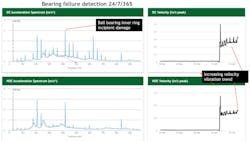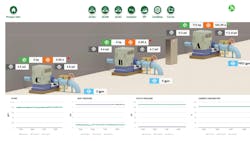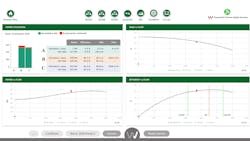Critical assets benefit from IIoT monitoring
Pumps are critical assets that are often overlooked for advanced condition monitoring. While many users focus on the main bearing vibration monitoring of critical pumps, monitoring bearing vibration is only the starting point. Having information that a bearing is starting to wear can save users considerably when it comes to unnecessary repairs and downtime — but the real savings start when one can replace the bearings before more catastrophic damage and expense occurs.
One steel mill in the United States, for example, took pump monitoring to a higher level by utilizing industrial internet of things (IIoT) capabilities. The steel mill requested that its pump monitoring package have the pump manufacturer’s pump curves built into a cloud-based IIoT platform. Also imbedded in the platform was a graph that plots how the operating pump is performing compared to its best efficiency point (BEP). The cloud-based IIoT platform takes data from multiple instruments, and produced flow, main drive end and non-drive end bearing vibration, pressure, process temperature, energy consumption of the motors, and suction inlet pressure are all monitored.
The pump monitoring platform was deployed by the steel mill in December 2019. The platform was monitoring three large centrifugal pumps with 750 hp motors. The normal operation through their DCS system was to run two pumps and have the third pump as a standby. Steel mills are massive consumers of water, and it requires 35,000 gallons of water to produce one ton of steel. This steel mill has 250 pumps ranging from 250 hp motors to 100 hp motors. In December, January 2020 and February 2020, due to cooler temperatures, the mill’s water consumption was significantly less, and the mill continued to run two pumps at lower flow rates. The IIoT display for the mill quickly showed that the pumps were running far below their BEP. When running pumps in this range significantly below their BEP, the pumps face continuous fatigue. In other words, companies are wearing their pumps out at a much faster rate than necessary. Alarms were sent to the user to turn off one of the pumps, and it was determined that the flow required could be achieved by using only one pump. By running only one pump, the pump being used quickly shot up to almost directly to its BEP. The other pump, meanwhile, was completely turned off, eliminating any wear at all to an idle pump.
This project originated from the steel mill because it was repairing or replacing expensive pumps much too frequently. The mill’s DCS controlled the operation of the pumps flawlessly but did not provide the user insight about how they could possibly reduce energy consumption, increase mean time between failure, reduce downtime and reduce repair/replacement costs. The repair cost for one of these pumps is approximately $40,000 to $45,000. If the pump requires a complete replacement, then the cost is approximately $95,000.
It was quickly noticed by the monitoring package that the energy consumption of pump C was much less than pump B or A. In the first six months, the user realized they could save $24,000 annually in energy consumption simply by using the most efficient pump. It was also detected that pump B had periods of increased vibration, indicating the need for bearing replacement. But the big picture here shows that if they run only one pump when possible, then they are creating no wear on pumps A and B, and pump C is saving them money every minute it runs.
The steel mill is located in the southern U.S., and when temperatures start to escalate, water consumption increases. This necessitates the need to run two pumps to produce the required flow. To do this, the mill had a choice to run pump C at its BEP, but pump B was only required to produce about half the flow of pump B. Thus, pump B was running off its pump curve far from the BEP and was being continuously stressed. As a result, the IIoT platform sent alarm recommendations that were made to increase the flow output of pump B to approach the BEP zone. This created less stress on the pump and even improved the energy efficiency of pump B, and the steel mill used a bypass loop to recirculate excess flow back to the source. In this case, the pump was not being stressed 100% of the time it was operating, ultimately resulting in less maintenance and downtime on very expensive pumps.
This scenario is just one example of how digitalization and monitoring with higher levels of analytics can serve as an add-on to existing DCS or SCADA systems. The monitoring system will never replace the DCS or SCADA system, but rather is an extension or enhancement that brings that higher level of analytics not found in conventional DCS or SCADA systems. In the above case, the steel mill is preparing to add this type of monitoring and intelligence to the next 10 pumps. If all 250 pumps were equipped with digitalization and monitoring previously described, the annual savings to this steel mill could total as much as $2 million to $4 million.
Although this article focuses on some large centrifugal pumps in the steel industry, there are plenty of other industries that use large and critically important pumps. Those industries include water and wastewater, pulp and paper, mining, chemical processing and others.
Digitalization example for pressure filtration
Another example of digitalization is adding monitoring to industrial pressure filtration units. The aforementioned steel mill, for example, has more than 10 pressure filters in its plant. These filtration units are typically semi-automatic or fully automatic machines. They are also somewhat complicated, and many have significant levels of automation or digitalization. Some are manned and require assistance for cake release, and others are more automated.
In the mining industry, a digitalized cloud-based monitoring system was developed for a zinc mining operation. This mine had three automatic vertical pressure filters, and it was struggling to meet production with these machines. The mine was starting to investigate purchasing another $1 million filter, and mine operators were under the assumption that these three machines were facing an 85% to 90% utilization rate.
As an alternative to purchasing a new filter, the mine was offered a digitalization package to monitor machine performance. The cost was fractional compared to investing in another filtration unit, and after a few months, the digitalization package began to capture valuable data. The complete filter plant had been controlled by a traditional DCS system. However, the DCS did as it was programmed and operated on normal logic. What it was not detecting was that these filters were waiting for multiple hours per day. Two of the filters were even waiting up to four total hours per day. Digitalization monitoring detected that the culprits were the compressed air system being recharged, the pressing water station and wash water station being recharged and waiting for the slurry tank to be refilled. The mine now has more than enough pressure filtration capacity to meet their current filtration needs.
The mine focused on fixing these delay issues, and the current result is that they can run two filters while the third is on standby. By fixing these issues, the mine, if it were able to keep the slurry tank filled, could produce 58 million more pounds per year. If the mine accomplished this with a 25% yield from production, their revenues could increase by more than $18 million.
Other benefits and employing artificial intelligence
It was detected via monitoring that there would be, at times, high-pressure spikes in the compressed air system and pressing water systems. These high-pressure spikes can destroy membranes and seals that create machine maintenance. The mine’s filters are now equipped with alarms so these problems can be addressed and so the filters do not face unwanted downtime and costly repairs. These filters are the final step to shipping the product to be smelted.
The mine owner took physical samples of the dried cake that comes out of these machines to determine the moisture content. The physical collection of the samples, however, was neither precise nor consistent. Artificial intelligence (AI) was used to study all the process inputs to the filters and accurately predict moisture content. It is suspected that the AI-predicted moisture content is more accurate than the physical sampling because it is inconsistent depending on the operating personnel.
Key performance indicators
The manager of the filtration plant at this mine said that he took various Excel spreadsheets from several sources each Monday to calculate the filter plant’s production for the previous week. With the digitalization solution provided, key performance indicators (KPIs) were developed with the process owner to provide insight into what they felt would benefit them. In this case, the KPIs focused on production, where the manager of the filtration plant can now see production hourly with no extra work. The mine also can now monitor what five items on the filters alarm most frequently. Lastly, the mine can also see each of the filter’s sources of waiting or downtime.
Conclusion
There are big players in the digitalization space, and they are focused primarily on plantwide systems added to conventional DCS or SCADA systems. These digitalization packages can cost millions, and they are rigid.
In some cases, however, tailor-made solutions for specific assets may prove more valuable and sustainable. In addition, virtually any asset can be digitalized with the correct supplier and instrumentation. There is always low-hanging fruit in the process industries. Focus on your pain points or bottlenecks first. And then find a company that can provide real-life examples of how they have created major benefits to other users.
Todd Loudin is president of North American operations and VP of global sales at Flowrox, Inc.
Flowrox, Inc.



